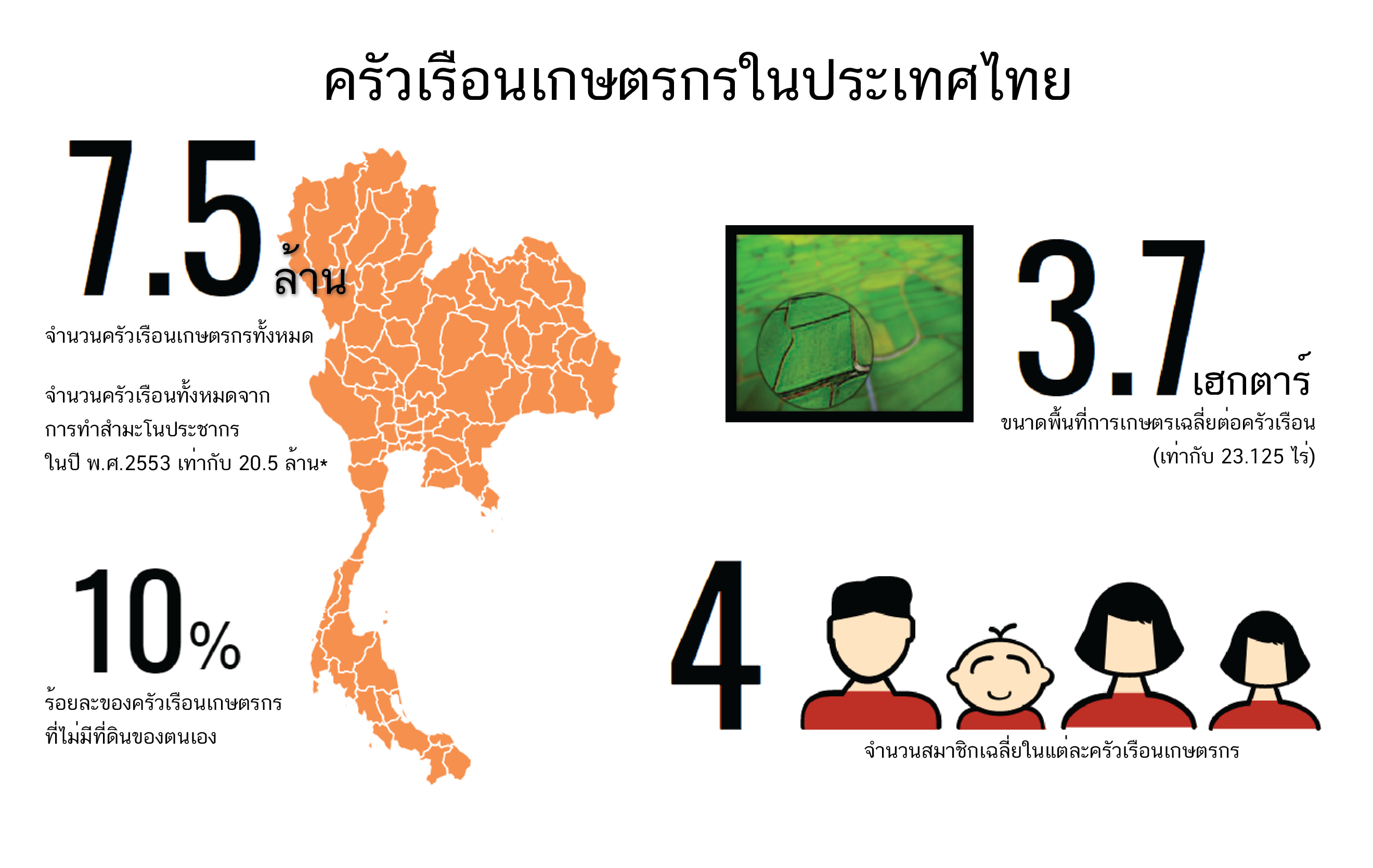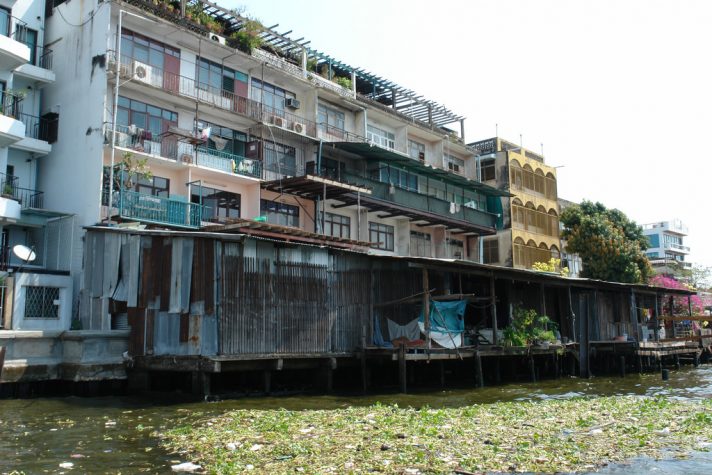ประเทศไทยมีความร่ำรวยที่สุดในภูมิภาคลุ่มแม่น้ำโขง ประเทศไทยยังมีนโยบายและแนวปฏิบัติด้านที่ดินที่ยาวนานรวมทั้งแนวปฏิบัติการครอบครองที่ดินของเอกชนโดยปราศจากการถูกแทรกแซง ประมวลกฎหมายที่ดินออกในปี พ.ศ. 2497 และได้แก้ไขเพิ่มเติมเมื่อเร็ว ๆ นี้ในปี พ.ศ. 25511 กรอบทางกฎหมายนี้ยังคงมีเสถียรภาพอย่างต่อเนื่องโดยการสืบทอดผ่านระบอบการเมืองที่ต่างกันไปในขณะที่สถานะของที่ดินมีการเปลี่ยนแปลงอย่างรวดเร็ว ในปี พ.ศ. 2504 ประเทศไทยมีพื้นที่ป่าไม้ร้อยละ 53 ของพื้นที่ทั้งประเทศ และในปี พ.ศ. 2549 พื้นที่ป่าไม้ลดลงเหลือร้อยละ 25 พื้นที่การเกษตรขยายตัวอย่างรวดเร็วโดยผ่านการตัดไม้ทำลายป่าแล้วลดลงจากการแปลงเป็นพื้นที่เมืองหรือการใช้ประโยชน์ในเชิงพาณิชย์2 ในช่วงไม่กี่ปีที่ผ่านมาพื้นที่การเกษตรได้ฟื้นตัวขึ้นและขณะนี้ร้อยละ 43 ของพื้นที่ทั้งหมดของประเทศถูกนำมาใช้เพื่อการเพาะปลูก 3 จากข้อมูลล่าสุดในปี พ.ศ. 2560 พื้นที่ป่าไม้เพิ่มขึ้นถึงร้อยละ 32 ของพื้นที่ทั้งหมด4 การเพิ่มจำนวนประชากร การเปิดเสรีของตลาดที่ดินและการเติบโตของธุรกิจการเกษตรเป็นปัจจัยสำคัญที่มีผลกระทบต่อการเป็นเจ้าของที่ดิน มีจำนวนเกษตรกรที่ไม่มีที่อยู่อาศัยหรือชาวนาที่ไม่มีที่ดินทำกินเป็นของตนเองเพิ่มมากขึ้นเรื่อย ๆ5 อย่างไรก็ดี เกษตรกรรายย่อยปัจจุบันยังคงไม่ได้รับความเท่าเทียมในการถือครองที่ดิน6

แหล่งที่มาของข้อมูล: องค์กรเพื่อการพัฒนาระหว่างประเทศของสหรัฐฯ กรรมสิทธิ์ในทรัพย์สินและการกำกับดูแลทรัพยากรของประเทศไทย *สำนักงานสถิติแห่งชาติ สร้างโดย ODI เมื่อเดือนพฤษภาคม พ.ศ.2559 ภายใต้ลิขสิทธิ์ CC BY-SA 4.0
นโยบายที่ดินและการบริหารจัดการที่ดิน
ระบบการบริหารที่ดินของไทยถือเป็นรูปแบบที่มีประสิทธิภาพและโปร่งใสสำหรับประเทศอื่น ๆ 7 กระทรวงต่างๆและหน่วยงานต่างๆมีส่วนเกี่ยวข้องโดยแต่ละหน่วยงานมีอำนาจตามกฎหมายต่างๆและมีหน้าที่ความรับผิดชอบที่แตกต่างกัน 8 ความรับผิดชอบด้านการจัดการที่ดินทางการเกษตรและที่ดินเพื่อการอยู่อาศัยรวมถึงการจัดและการจดทะเบียนที่ดินอยู่ในความรับผิดชอบของกรมที่ดิน กระทรวงมหาดไทยซึ่งดำเนินการผ่านระบบที่ดินของสำนักงานที่ดินจังหวัดและสำนักงานที่ดินอำเภอ 9 ขั้นตอนการบริหารส่วนใหญ่สามารถดำเนินการได้เสร็จสิ้นภายในเวลาไม่ถึง 1 วันและการจดทะเบียนที่ดินจะมีมูลค่าประมาณร้อยละ 1 ของมูลค่าทรัพย์สิน 10
คณะกรรมการจัดสรรที่ดินแห่งชาติที่จัดตั้งขึ้นโดยประมวลกฎหมายที่ดินโดยมีรัฐมนตรีว่าการกระทรวงทรัพยากรธรรมชาติและสิ่งแวดล้อมเป็นประธาน 11 ก่อตั้งขึ้นในปี พ.ศ. 2545 กระทรวงทรัพยากรธรรมชาติและสิ่งแวดล้อมรับผิดชอบการจัดการน้ำและป่าไม้และภารกิจอื่น ๆ 12 ระหว่างหน่วยงานที่เกี่ยวข้องภายใต้กระทรวงทรัพยากรธรรมชาติและสิ่งแวดล้อม กรมป่าไม้ซึ่งมีบทบาทที่เข้มแข็งในการจัดการป่าสงวนแห่งชาติและพื้นที่คุ้มครอง13 กระทรวงเกษตรและสหกรณ์ ได้แก่ สํานักงานปฏิรูปที่ดินเพื่อเกษตรกรรมและกรมพัฒนาที่ดินมีหน้าที่จัดสรรที่ดินให้แก่เกษตรกรและการจำแนกประเภทของการใช้ประโยชน์ที่ดินตามลำดับ 14

แหล่งชุมชนแออัดริมคลองในกรุงเทพมหานคร ภาพโดย erozen แหล่งข้อมูลจากฟลิคเกอร์ เมื่อวันที่ 26 กุมภาพันธ์ พ.ศ.2552 ภายใต้ลิขสิทธิ์ของ CC BY-NC 2.0
ประมวลกฎหมายที่ดิน พ.ศ. 2497 ได้แบ่งแยกระหว่างทรัพย์สินส่วนบุคคลซึ่งได้รับการคุ้มครองตามกฎหมาย และที่ดินของรัฐซึ่งรวมถึงที่ดินทั้งหมด “ซึ่งไม่มีผู้ครอบครองกรรมสิทธิ์” ที่ดินของรัฐอาจให้สัมปทาน การให้เช่าหรือเช่าโดยรัฐบาล มีบทบัญญัติที่แยกต่างหากเกี่ยวกับการทำเหมืองแร่และป่าไม้ 15 ไทยเป็นประเทศเดียวในเอเชียตะวันออกเฉียงใต้ที่กฏหมายอนุญาตให้นักลงทุนต่างชาติเข้าครอบครองที่ดินภายใต้ข้อจำกัดเฉพาะและในจำนวนที่ต่ำกว่าประชาชนชาวไทย 16 กฎหมายที่เกี่ยวข้องอื่น ๆ ได้แก่ พระราชบัญญัติการปฏิรูปที่ดินเพื่อเกษตรกรรม พ. ศ. 2526 พระราชบัญญัติพัฒนาที่ดินพ.ศ. 2526 และพระราชบัญญัติการจัดรูปที่ดิน พ.ศ. 2547 17 ในปี พ.ศ. 2550 ประเทศไทยได้จัดทำร่างพระราชบัญญัติป่าชุมชนหลังจากได้มีการปรึกษาหารือกันเป็นระยะเวลากว่า 15 ปีระหว่างกรมป่าไม้และกลุ่มประชาสังคม 18 อย่างไรก็ตามในปี 2552 ศาลรัฐธรรมนูญวินิจฉัยว่าพระราชบัญญัติอุทยานแห่งชาติ พ.ศ. 2504 มีผลบังคับใช้และกฎหมายป่าชุมชนก็ไม่เคยเป็นกฎหมาย 19 รัฐมนตรีว่าการกระทรวงทรัพยากรธรรมชาติและสิ่งแวดล้อมกล่าวว่าโครงการจัดสรรที่ดินหลายแห่งล้มเหลวเนื่องจากที่ดินตกไปอยู่ในมือของนายทุนที่ดิน 20
ตามรัฐธรรมนูญฉบับชั่วคราวที่ประกาศใช้โดยรัฐบาลทหารที่เข้ามามีอำนาจเมื่อพ.ศ. 2557 คณะรักษาความสงบแห่งชาติ “จะมีอำนาจสั่งให้ยับยั้งหรือดำเนินการใด ๆ ไม่ว่าการกระทำดังกล่าวจะมีผลบังคับใช้กับฝ่ายนิติบัญญัติ ฝ่ายบริหารหรือตุลาการ” 21 ซึ่งรวมถึงการแก้ไขหรือการยกเลิกกฎหมายหรือวิธีปฏิบัติที่มีอยู่ที่รวมถึงเรื่องเกี่ยวกับที่ดิน ตัวอย่าง เช่น ในเดือนพฤษภาคม พ.ศ. 2558 นายกรัฐมนตรี พลเอกประยุทธ์ จันทร์โอชา ได้ออกคำสั่งฉบับที่ 17/2558 เพื่อประกาศเขตเศรษฐกิจพิเศษ 5 เขต (SEZs) ทำให้เกิดการเวนคืนที่ดิน 22 เพื่อลดความเหลื่อมล้ำในการเข้าถึงที่ดินรัฐบาลจึงมีแผนที่จะจัดสรรที่ดินของรัฐจำนวน 195,000 ไร่ (31,200 เฮกตาร์) ใน 47 จังหวัดให้แก่กว่า 43,000 ครอบครัวที่ไม่มีที่ดินซึ่งที่ดินจะได้รับการจัดการโดยสหกรณ์ซึ่งไม่ใช่ของเอกชน 23
ตั้งแต่การประกาศใช้รัฐธรรมนูญฉบับชั่วคราว ปรากฎว่ามีการประกาศใช้กฎหมายอื่น ๆ ที่เกี่ยวข้องกับที่ดิน เช่น พระราชบัญญัติการจัดสรรที่ดิน (ฉบับที่ 2) พ.ศ. 2558 เป็นกรอบกฎหมายหลักเพื่อใช้พัฒนาการใช้ที่ดินในประเทศ พระราชบัญญัติการเช่าที่ดินเพื่อเกษตรกรรม (ฉบับที่ 2) พ.ศ. 2559 เป็นผลจากนโยบายการปฏิรูปเพื่อปกป้องกิจกรรมเพื่อเกษตรกรรมของประเทศ โดยพระราชบัญญัตินี้กำหนดให้ผู้เช่าซื้อต้องแจ้งรัฐบาลหากเกษตรกรผู้เช่าไม่ต้องการใช้ที่ดินเพื่อการเกษตรอีกต่อไปและหากพบที่ดินถูกทิ้งร้างไว้โดยไม่ทำการเกษตรจะมีระวางค่าปรับตามที่กฎหมายระบุ แต่กฎหมายนี้ยังมีจุดอ่อนที่ไม่เอื้อต่อเกษตรกรที่ทำไร่หมุนเวียน นอกจากนี้ กฎหมายล่าสุดที่มีการประกาศใช้คือ พระราชบัญญัติภาษีที่ดินและสิ่งปลูกสร้าง พ.ศ. 2562 ที่ยกเลิกกฎหมายภาษีที่ดินก่อนหน้านี้ และสร้างโครงสร้างภาษีใหม่สำหรับเจ้าของที่ดิน
การจำแนกประเภทที่ดิน
ประเทศไทยได้ดำเนินแผนงานจัดสรรที่ดินขนาดใหญ่ตั้งแต่ปี พ.ศ. 2527-2547 มีเป้าหมายเพื่อกำหนดรูปแบบการครอบครองที่มีอยู่แต่ไม่มีเอกสารการถือครองให้มีความชัดเจนและปรับปรุงการบริหารจัดการที่ดินในระบบกฎหมายที่มีความครอบคลุม มีการออกเอกสารสิทธิ์จำนวนมากกว่า 11.50 ล้านฉบับในช่วงเวลานี้ 24 โครงการนี้ได้รับทุนสนับสนุนจากรัฐบาลไทยธนาคารโลกและรัฐบาลออสเตรเลียและได้รับการยกย่องว่าประสบความสำเร็จเป็นอย่างดี 25
อันที่จริงแล้ว ที่ดินที่ไม่ได้จัดเป็นประเภทเป็นที่ดินส่วนตัวถือเป็นพื้นที่ป่าไม้ของรัฐ ซึ่งข้อมูลปีพ.ศ. 2560 พบว่ามีพื้นที่ป่าไม้ของรัฐมีจำนวนร้อยละ 40 ของที่ดินทั้งหมด26 โดยแบ่งได้เป็นพื้นที่ป่าสงวนแห่งชาติและพื้นที่ป่าอนุรักษ์
เกษตรกรรมรายย่อยและธุรกิจการเกษตรขนาดใหญ่ยังคงมีการใช้ที่ดินส่วนตัวอย่างสำคัญ27 ถึงแม้ว่าเกษตรกรไทยรุ่นใหม่จะย้ายไปทำงานในเมืองมากขึ้น แต่ครอบครัวของพวกเขาก็ยังคงรักษาที่ดินเพื่อการเกษตรเพื่อความมั่นคงของครอบครัว28
นักวิเคราะห์อ้างว่าสิทธิของผู้ถือครองที่ดินรายย่อยยังคงน้อยกว่าองค์กรหรือผู้ถือครองที่ดินรายใหญ่เนื่องจากมีสิทธิในกฎหมายต่างกัน 29 ในขณะที่คนที่มีเอกสารสิทธิ์จะมีความมั่นคงในการใช้ประโยชน์ที่ดิน ระบบยังไม่ครอบคลุมถึงการตั้งถิ่นฐานอย่างไม่เป็นทางการในเมืองหรือผู้ครอบครองที่ดินป่า ในกรณีดังกล่าวจะมีการออกสิทธิการใช้งานชั่วคราวและสิทธิการใช้งานประเภทอื่น ๆ โดยมีสิทธิน้อยกว่าการเป็นเจ้าของเต็มรูปแบบ 30
เกือบร้อยละ 19 ของที่ดินในประเทศไทยถูกจัดให้เป็นพื้นที่คุ้มครองรวมถึงอุทยานแห่งชาติและเขตรักษาพันธุ์สัตว์ป่าซึ่งเป็นอัตราสูงสุดของพื้นที่แผ่นดินใหญ่ในภูมิภาคเอเชียตะวันออกเฉียงใต้ยกเว้นกัมพูชา31 กลุ่มชนพื้นเมืองและผู้อพยพที่อาศัยอยู่ในที่ราบสูงภาคเหนือปฏิบัติตามกฎหมายจารีตประเพณีและดูแลการเข้าถึงและการใช้ประโยชน์ที่ดิน โดยกลุ่มชนพื้นเมืองเหล่านี้มักจะยังไม่มีสิทธิได้สัญชาติเป็นพลเมืองเต็มรูปแบบ32 นอกจากนี้ ที่ดินส่วนใหญ่จัดเป็นที่ดินป่าไม้ของรัฐและกฎหมายของประเทศไม่ยอมรับสิทธิที่ดินตามธรรมเนียมปฏิบัติ33 ร่างกฎหมายป่าชุมชนที่นำเสนอต่อรัฐสภาฯ เพื่อพิจารณาตั้งแต่ปี พ.ศ. 2550 แต่ไม่ได้รับการอนุมัติ34 ยอมรับสิทธิตามกฎหมายของชุมชนในบริเวณป่าในการรักษาและจัดการพื้นที่ป่า แต่สิทธิของชุมชนจำกัดเฉพาะ “ผู้อยู่อาศัยในป่าเดิม”ที่อาศัยอยู่ในพื้นที่ป่าเป็นเวลาอย่างน้อยสิบปี อ้างถึงกลุ่มสนับสนุนภาคประชาสังคม พระราชบัญญัติป่าชุมชนทำให้ชุมชนที่อาศัยอยู่บริเวณชายขอบของป่าคุ้มครองจำนวน 20,000 ชุมชนสูญเสียสิทธิ 35
เช่นเดียวกับในหลายประเทศ เพศเป็นปัจจัยที่ส่งผลต่อการเข้าถึงที่ดิน ตามกฎหมายผู้หญิงมีสิทธิเท่าเทียมกันในการเป็นเจ้าของที่ดิน แต่โดยธรรมเนียมปฏิบัติผู้ชายมักควบคุมที่ดินส่วนใหญ่โดยเฉพาะในพื้นที่ชนบท36 สิ่งนี้ยังมีความแตกต่างจากระบบการถือครองที่ดินเดิมในอดีตที่ผู้หญิงมีสิทธิดูแลจัดการที่ดิน37
การโอนที่ดินและการเช่าที่ดินสาธารณะ
ที่ดินของทั้งภาคเอกชนและภาครัฐสามารถให้เช่าได้ถึง 30 ปี พื้นที่การเกษตรระหว่างร้อยละ 11 ถึงร้อยละ 30 อยู่ภายใต้รูปแบบการเช่ารูปแบบใดรูปแบบหนึ่ง 38 มีที่ดินให้เช่ามากถึง 1 ใน 3 ของพื้นที่การเกษตรในพื้นที่ภาคกลางแต่ในภูมิภาคอื่น ๆมีปริมาณต่ำกว่ามาก ครัวเรือนที่ไม่มีที่ดินทำกินมีสัดส่วนร้อยละ 6 และร้อยละ 14 ของพื้นที่ทั้งหมดในทศวรรษ 2533 39
รัฐธรรมนูญฉบับก่อน ๆ ของไทยรับประกันการชดเชยการเวนคืนทรัพย์สินของเอกชนเพื่อประโยชน์สาธารณะ ขั้นตอนเหล่านี้ได้รับการปฏิบัติตามระบบกฎหมาย โดยมีข้อยกเว้นหลายประการในกรณีของชนพื้นเมืองที่สูญเสียที่ดินเพื่อพัฒนาโครงสร้างพื้นฐาน 40 รัฐธรรมนูญ พ.ศ. 2557 ไม่มีบทบัญญัติใด ๆ เกี่ยวกับการโอนที่ดิน
แหล่งที่มาของข้อมูล: การนิคมอุตสาหกรรมแห่งประเทศไทย สร้างโดย ODI เมื่อเดือนมิถุนายน 2559 ภายใต้ลิขสิทธิ์ CC BY-SA 4.0 เข้าไปดูข้อมูล
เมื่อพ.ศ. 2557 รัฐบาลไทยได้อนุมัติแผนพัฒนาเขตเศรษฐกิจพิเศษจำนวน 10 แห่ง ครอบคลุมพื้นที่ 90 อำเภอในพื้นที่ชายแดน เขตเศรษฐกิจพิเศษเป็นส่วนหนึ่งของยุทธศาสตร์ระดับชาติเพื่อกระตุ้นการเติบโตทางเศรษฐกิจ ดึงดูดการลงทุนจากต่างประเทศ สนับสนุนการพัฒนาพื้นที่ชายแดนและสนับสนุนการรวมกลุ่มของอาเซียน 41 พื้นที่ 5 เขตเศรษฐกิจพิเศษแรกได้รับการประกาศเมื่อ พ. ศ. 2558 ครอบคลุมพื้นที่จำนวน 1.83 ล้านไร่ (293,200 เฮกตาร์) 42 ในเดือนมกราคม พ.ศ. 2559 รัฐบาลได้ประกาศแผนการจัดหาที่ดินระยะที่ 2 ของเขตเศรษฐกิจพิเศษจำนวน 14,382 ไร่ (2,301 เฮกตาร์)43 เขตเศรษฐกิจใหม่นี้เป็นพื้นที่นอกเหนือจาก 44 สวนอุตสาหกรรมที่มีอยู่และอุทยานเทคโนโลยี 6 แห่งที่บริหารโดยการนิคมอุตสาหกรรมแห่งประเทศไทย (กนอ.)44
การระงับข้อพิพาทด้านที่ดิน
ก่อนที่จะมีการประกาศใช้ที่ดินอย่างกว้างขวาง ที่ดินในพื้นที่สาธารณะจำนวนมากต้องเผชิญกับปัญหาที่พบบ่อยจากการถูกบุกรุก การยึดครองที่ผิดกฎหมายและการเรียกร้องที่ทับซ้อนกัน ในปัจจุบันความขัดแย้งในที่ดินส่วนใหญ่จะกระจุกตัวอยู่ในพื้นที่ป่าที่มีประเภทการใช้ประโยชน์ที่แตกต่างกันรวมถึงอุทยานแห่งชาติและพื้นที่คุ้มครอง สาเหตุหลัก ๆ ได้แก่ การกวาดล้างและการใช้ประโยชน์ที่ดินป่าไม้ก่อนการประกาศเป็นป่าสงวน การโยกย้ายถิ่นเข้ามาอยู่อาศัยเนื่องจากการแข่งขันด้านทรัพยากรทางเศรษฐกิจ การเก็งกำไรและการสมรู้ร่วมคิด ความคลุมเครือของนโยบายและการซ้อนทับกันของระบบราชการ45 ผู้มีส่วนเกี่ยวข้องเกี่ยวกับความขัดแย้งของที่ดินในผืนป่าคือชุมชนชนพื้นเมือง ความสนใจด้านการอนุรักษ์ (รวมถึงกรมป่าไม้) และบริษัทต่างๆที่มีการพัฒนาโครงสร้างพื้นฐานและทำเหมืองแร่
อ้างถึงองค์การสหประชาชาติ การหายตัวไปและการฆาตกรรมที่ไม่สามารถอธิบายได้ถูกเชื่อมโยงว่าเกี่ยวกับการเคลื่อนไหวด้านที่ดิน กรณีเด่นมีตั้งแต่ พ.ศ. 2557 ได้แก่ นายชัย บุญทองเล็ก หัวหน้าหมู่บ้านในจังหวัดสุราษฎร์ธานีที่เกี่ยวข้องกับความขัดแย้งเรื่องที่ดินกับสวนปาล์มน้ำมัน และนาย ปอชาลี รักษ์เจริญ (นายบิลลี่) นักกิจกรรมชาวกะเหรี่ยงผู้ฟ้องร้องเจ้าหน้าที่โดยกล่าวหาว่าบ้านเรือนของชาวพื้นเมืองจำนวน 20 ครอบครัวในอุทยานแห่งชาติแก่งกระจานถูกเจ้าหน้าที่ทำลาย46 เมื่อเร็ว ๆ นี้ เด่น กัมเล ผู้นำด้านสิทธิที่ดินในจังหวัดชัยภูมิได้สูญหายไปเมื่อเดือนเมษายน พ.ศ. 2559 หลายสัปดาห์ต่อมาผู้ว่าราชการจังหวัดได้ออกหมายจับเขา47
ข้อพิพาทเรื่องที่ดินส่วนใหญ่ได้รับการจัดการอย่างสันติและมีประสิทธิภาพในระบบศาลแพ่ง48 ชุมชนเกษตรกรรมได้ใช้กลยุทธ์แบบผสมผสานด้านกฎหมายและยุทธศาสตร์การดำเนินการโดยตรงเพื่อผลักดันให้เกิดการปฏิรูปที่ดิน ตัวอย่าง เช่น สหพันธ์ชาวนาภาคเหนือและองค์กรพัฒนาและสร้างความเข้มแข็งของหมู่บ้านได้ร่วมมือกับขบวนการเคลื่อนไหวเพื่อประชาชนเพื่อความเท่าเทียมกันในสังคมให้มากขึ้นได้ทำการรณรงค์ให้มีการออกโฉนดชุมชน การเก็บภาษีที่ดินในอัตราก้าวหน้าและจัดตั้งธนาคารที่ดินแห่งชาติเพื่อช่วยในการแจกจ่ายที่ดิน 49 แม้ว่าจะมีช่องทางสำหรับเกษตรกรรายย่อยในการร้องเรียนตามสิทธิการถือครองที่ดิน แต่บ่อยครั้งพบว่าการร้องเรียนใช้เวลานานและมีค่าใช้จ่ายสูง และยังพบปัญหาการมีอคติที่ไม่เป็นธรรม50
ปรับปรุงล่าสุด: มีนาคม 2562
References
- 1. ราชอาณาจักรไทย ประมวลกฎหมายที่ดินออกตามรัฐธรรมนูญ พ.ศ. 2497 แก้ไขเพิ่มเติมฉบับที่ 12 พ.ศ. 2551.
- 2. อรพันธ์ ณ บางช้าง ศรีเสาวลักษณ์ ข้อมูลการครอบครองที่ดินในประเทศไทย องค์การอาหารและการเกษตรแห่งสหประชาชาติ พ.ศ. 2549 สืบค้นเมื่อเดือนเมษายน 2559
- 3. ธนาคารโลก ตัวชี้วัดการพัฒนาโลก สืบค้นเมื่อเดือนเมษายน 2559
- 4. M.L. Ingalls. 2562. สถานภาพของที่ดินในภูมิภาคลุ่มน้ำโขง.สืบค้นเมื่อ 21 มีนาคม 2562.
- 5. เจสัน ลูบันสกี้ ที่ดินคือชีวิต: กรณีศึกษาเรื่องการรณรงค์ปฏิรูปที่ดินในเขตภาคเหนือ หน้าที่ 7 สถาบันบัณฑิต SIT 2555 สืบค้นเมื่อเดือนเมษายน 2559.
- 6. M.L. Ingalls. 2562. สถานภาพของที่ดินในภูมิภาคลุ่มน้ำโขง.สืบค้นเมื่อ 21 มีนาคม 2562.
- 7. ข้อมูลประเทศขององค์กรการพัฒนาระหว่างประเทศของสหรัฐอเมริกา: สิทธิในทรัพย์สินและการจัดการทรัพยากร 2554 สืบค้นเมื่อเดือนเมษายน 2559
- 8. อรพันธ์ ณ บางช้าง ศรีเสาวลักษณ์ ข้อมูลการครอบครองที่ดินในประเทศไทย องค์การอาหารและการเกษตรแห่งสหประชาชาติ พ.ศ. 2549 สืบค้นเมื่อเดือนเมษายน 2559
- 9. เอส เฮลวิก กรมที่ดินคืออะไร? นักกฎหมายไพรซ์สานนท์ 18 กุมภาพันธ์ 2557 สืบค้นเมื่อเดือนเมษายน 2559
- 10. โจนัส ดาลลิงเกอร์ “การพัฒนาปาล์มน้ำมันในประเทศไทย: ข้อพิจารณาด้านเศรษฐกิจ สังคมและสิ่งแวดล้อม” บรรณาธิการโดย เอ็ม โคลเชสเตอร์และ เอ็ม เชา การขยายตัวของปาล์มน้ำมันในภูมิภาคเอเชียตะวันออกเฉียงใต้: แนวโน้มและนัยยะสำหรับชุมชนท้องถิ่นและชนเผ่าพื้นเมือง แผนงานคนป่าและเพอกัมพูลัน สาวิต วอช (Perkumpulan Sawit Watch) 2554 หน้า 32
- 11. ประมวลกฎหมายที่ดินมาตรา 14
- 12. กระทรวงทรัพยากรธรรมชาติและสิ่งแวดล้อม ข้อมูลของหน่วยงาน 2554 สืบค้นเมื่อเดือนเมษายน 2559
- 13. อรพันธ์ ณ บางช้าง ศรีเสาวลักษณ์ ข้อมูลการครอบครองที่ดินในประเทศไทย องค์การอาหารและการเกษตรแห่งสหประชาชาติ พ.ศ. 2549 สืบค้นเมื่อเดือนเมษายน 2559
- 14. ข้อมูลประเทศขององค์กรการพัฒนาระหว่างประเทศของสหรัฐอเมริกา: สิทธิในทรัพย์สินและการจัดการทรัพยากร หน้า 8 2554 สืบค้นเมื่อเดือนเมษายน 2559
- 15. ประมวลกฎหมายที่ดินมาตรา 12
- 16. ประมวลกฎหมายที่ดินมาตรา 96 ทวิ 96 ตรี (แก้ไขเมื่อ พ.ศ. 2542)
- 17. ข้อมูลประเทศขององค์กรการพัฒนาระหว่างประเทศของสหรัฐอเมริกา: สิทธิในทรัพย์สินและการจัดการทรัพยากร 2554 สืบค้นเมื่อเดือนเมษายน 2559
- 18. อภิญญา วิภาตะโยธิน “กฏหมายป่าชุมชนได้รับความเห็นชอบ” หนังสือพิมพ์บางกอกโพสท์ วันที่ 22 พฤศจิกายน 2550 สืบค้นเมื่อเดือนเมษายน 2559
- 19. ศาลรัฐธรรมนูญฉบับที่ 15/2552 (2009) อ้างถึงในบัญชารัตน์ แซ่กั๊ว “การใช้กลยุทธ์วัฒนธรรมในกระบวนการเรียกร้องสิทธิในป่าชุมชน” จดหมายข่าวศูนย์มานุษยวิทยาสมเด็จเจ้าฟ้ามหาจักรีสิรินธร (มีนาคม 2556) หน้า 18-20
- 20. ไทยพีบีเอส “คณะกรรมการ 3 คณะที่จะจัดตั้งขึ้นเพื่อทำงานโครงการจัดสรรที่ดินใหม่” 7 พฤศจิกายน 2557
- 21. รัฐธรรมนูญแห่งราชอาณาจักรไทย (ชั่วคราว) พ.ศ. 2557 มาตรา 44 การแปลเป็นภาษาอังกฤษเข้าถึงได้ที่
- 22. วรรษมน อุจจรินทร์ “ผู้เชี่ยวชาญเตือนอันตรายของมาตรา 44” เดอะเนชั่น (กรุงเทพ) วันที่ 25 มกราคม 2559
- 23. ไทยพีบีเอส “รัฐบาลจะแจกจ่ายที่ดินของรัฐให้กับผู้ที่ไม่มีที่ดิน” 29 กุมภาพันธ์ 2559 ; รัฐบาลไทย “นายกรัฐมนตรีเป็นประธานการประชุมคณะกรรมการที่ดินแห่งชาติ” 2558
- 24. ดี เบลดโซ “การเพิ่มที่ดินและการจดทะเบียนสามารถลดความยากจนได้อย่างไร” บรรณาธิการโดย จอห์น ดับเบิ้ลยู บรูซ และคณะ การปฏิรูปกฎหมายที่ดิน: การบรรลุวัตถุประสงค์ของนโยบายการพัฒนา 2549 หน้า 145
- 25. ซี โบว์แมน กรณีศึกษา“โครงการจำแนกที่ดินของประเทศไทย” ได้รับการนำเสนอในการสัมมนาเพื่อยกระดับเรื่องการลดความยากจน: การลดความยากจนเสริมสร้างการเติบโตอย่างยั่งยืน–สิ่งที่ได้ผลคืออะไร อะไรที่ไม่ได้ผลและทำไมต้องมีการแลกเปลี่ยนระดับโลกเพื่อยกระดับความสำเร็จ (เซี่ยงไฮ้ 2547)
- 26. M.L. Ingalls. 2562. สถานภาพของที่ดินในภูมิภาคลุ่มน้ำโขง.สืบค้นเมื่อ 21 มีนาคม 2562.
- 27. M.L. Ingalls. 2562. สถานภาพของที่ดินในภูมิภาคลุ่มน้ำโขง.สืบค้นเมื่อ 21 มีนาคม 2562.
- 28. M.L. Ingalls. 2562. สถานภาพของที่ดินในภูมิภาคลุ่มน้ำโขง.สืบค้นเมื่อ 21 มีนาคม 2562.
- 29. อรพันธ์ ณ บางช้าง ศรีเสาวลักษณ์ ข้อมูลการครอบครองที่ดินในประเทศไทย องค์การอาหารและการเกษตรแห่งสหประชาชาติ พ.ศ. 2549 สืบค้นเมื่อเดือนเมษายน 2559
- 30. เอ เบิร์น “โครงการเอกสารสิทธิ์ที่ดินในชนบทระยะเวลา 20 ปีในประเทศไทย” หน้า 8-9 เอกสารประกอบการจัดเตรียมสำหรับรายงานการพัฒนาโลก พ.ศ. 2548
- 31. ธนาคารโลก ตัวชี้วัดการพัฒนาโลก สืบค้นเมื่อเดือนเมษายน 2560.
- 32. M.L. Ingalls. 2562. สถานภาพของที่ดินในภูมิภาคลุ่มน้ำโขง.สืบค้นเมื่อ 21 มีนาคม 2562.
- 33. ข้อมูลประเทศขององค์กรการพัฒนาระหว่างประเทศของสหรัฐอเมริกา. สิทธิในทรัพย์สินและการจัดการทรัพยากร หน้า 6. 2554. สืบค้นเมื่อเดือนเมษายน 2559.
- 34. M.L. Ingalls. 2562. สถานภาพของที่ดินในภูมิภาคลุ่มน้ำโขง.สืบค้นเมื่อ 21 มีนาคม 2562.
- 35. เอ็ม เวทเทอร์บาย และ สมหญิง สุนทรวงศ์ “พระราชบัญญัติป่าชุมชนของประเทศไทย” ความคิดริเริ่มสิทธิและทรัพยากร 2551 สืบค้นเดือนเมษายน 2559
- 36. ข้อมูลประเทศขององค์กรการพัฒนาระหว่างประเทศของสหรัฐอเมริกา: สิทธิในทรัพย์สินและการจัดการทรัพยากร หน้า 8. 2554. สืบค้นเมื่อเดือนเมษายน 2559.
- 37. M.L. Ingalls. 2562. สถานภาพของที่ดินในภูมิภาคลุ่มน้ำโขง.สืบค้นเมื่อ 21 มีนาคม 2562.
- 38. ข้อมูลประเทศขององค์กรการพัฒนาระหว่างประเทศของสหรัฐอเมริกา: สิทธิในทรัพย์สินและการจัดการทรัพยากร หน้า 7 2554 สืบค้นเมื่อเดือนเมษายน 2559
- 39. เอ็ก จิเน่ “เพาะปลูกหรือให้เช่า? ความมั่นคงในที่ดินในชนบทของไทย “ (เอกสารที่ไม่ได้ตีพิมพ์) ธนาคารโลก 2547 หน้า 9 สืบค้นเมื่อเดือนเมษายน 2559
- 40. ข้อมูลประเทศขององค์กรการพัฒนาระหว่างประเทศของสหรัฐอเมริกา: สิทธิในทรัพย์สินและการจัดการทรัพยากร หน้า 9 2554 สืบค้นเมื่อเดือนเมษายน 2559
- 41. คณะกรรมการส่งเสริมการลงทุนของประเทศไทย คู่มือการลงทุนในเขตเศรษฐกิจพิเศษ หน้า 4-5 สืบค้นเมื่อเดือนเมษายน 2559.
- 42. โชติกา ชูมณี และศรีนรินทร์ เผ่าพงษ์ไพบูลย์ เขตเศรษฐกิจพิเศษของไทย: แผนงานระดับชาติและโอกาสใหม่ ๆ ที่น่าจับตามอง ศูนย์ข่าวกรองเศรษฐกิจธนาคารไทยพาณิชย์ เดือนมกราคม 2558 สืบค้นเมื่อเดือนเมษายน 2559
- 43. รัฐบาลไทย นายกรัฐมนตรีเป็นประธานในการประชุมคณะกรรมการนโยบายเขตเศรษฐกิจเขตพิเศษ วันที่ 18 มกราคม 2559.
- 44. องค์การพัฒนาอุตสาหกรรมแห่งสหประชาชาติ เขตเศรษฐกิจในอาเซียน หน้า 79-80. สืบค้นเมื่อเดือนเมษายน 2559.
- 45. อรพันธ์ ณ บางช้าง ศรีเสาวลักษณ์ ข้อมูลการครอบครองที่ดินในประเทศไทย องค์การอาหารและการเกษตรแห่งสหประชาชาติ พ.ศ. 2549 สืบค้นเมื่อเดือนเมษายน 2559.
-
46. สำนักข่าวเอ เอฟ พี “นักกิจกรรมด้านสิทธิการครอบครองที่ดินชาวไทยถูกสังหาร” เดอะเนชั่น (กรุงเทพ) 13 กุมภาพันธ์ 2558 สืบค้นเมื่อเดือนเมษายน 2559;
ข่าวกะเหรี่ยง “ความกังวลที่ร้ายแรงสำหรับการหายตัวไปของนักกิจกรรมชาวกะเหรี่ยง” 25 เมษายน 2557. - 47. กองหลังแนวหน้า ประวัติกรณี: เด่น กัมเล สืบค้นเมื่อเดือนเมษายน 2559.
- 48. ข้อมูลประเทศขององค์กรการพัฒนาระหว่างประเทศของสหรัฐอเมริกา: สิทธิในทรัพย์สินและการจัดการทรัพยากร หน้า 9 2554 สืบค้นเมื่อเดือนเมษายน 2559.
- 49. เจสัน ลูบันสกี้ ที่ดินคือชีวิต: กรณีศึกษาเรื่องการรณรงค์ปฏิรูปที่ดินในเขตภาคเหนือ หน้าที่ 7 สถาบันบัณฑิต SIT 2555 สืบค้นเมื่อเดือนเมษายน 2559.
- 50. M.L. Ingalls. 2562. สถานภาพของที่ดินในภูมิภาคลุ่มน้ำโขง.สืบค้นเมื่อ 21 มีนาคม 2562.

